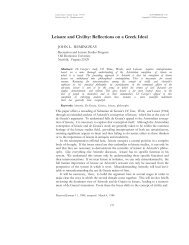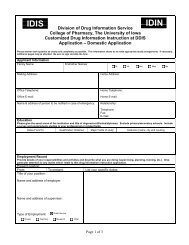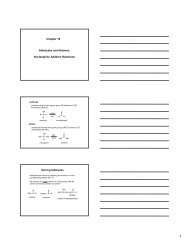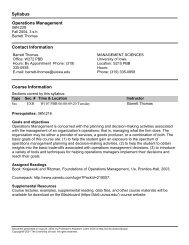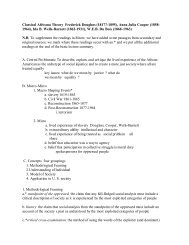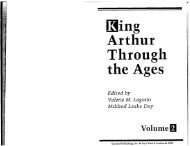Twenty-Five Years of Batson: An Introduction to ... - University of Iowa
Twenty-Five Years of Batson: An Introduction to ... - University of Iowa
Twenty-Five Years of Batson: An Introduction to ... - University of Iowa
You also want an ePaper? Increase the reach of your titles
YUMPU automatically turns print PDFs into web optimized ePapers that Google loves.
2012] TWENTY-FIVE YEARS OF BATSON 1395<br />
I. FROM STRAUDER TO SWAIN TO BATSON: THE EQUAL PROTECTION<br />
PROHIBITION ON DISCRIMINATORY JUROR SELECTION<br />
The Supreme Court found roots for <strong>Batson</strong> in a number <strong>of</strong> its prior<br />
decisions. The two most significant precedents were Strauder v. West Virginia 6<br />
and Swain v. Alabama. 7 This section summarizes those two opinions, explains<br />
<strong>Batson</strong>’s holding, and explores its premises.<br />
A. STRAUDER V. WEST VIRGINIA: STATUTORY PROVISIONS FOR ALL-WHITE VENIRES<br />
AND EQUAL PROTECTION<br />
Strauder v. West Virginia—decided more than a century before <strong>Batson</strong>—<br />
involved a state statute providing that only “white male persons” were<br />
eligible “<strong>to</strong> serve as jurors.” 8 Strauder, a black man indicted for murder by<br />
an all-white, all-male grand jury, moved “<strong>to</strong> quash the venire,” asserting that<br />
the preclusion <strong>of</strong> blacks from jury service “was unconstitutional.” 9 After the<br />
trial court overruled this motion, an all-male, all-white jury convicted<br />
Strauder, and the West Virginia Supreme Court affirmed. 10<br />
The question before the Supreme Court was whether, under “the<br />
Constitution and laws <strong>of</strong> the United States, every citizen . . . has a right <strong>to</strong> a<br />
trial <strong>of</strong> an indictment against him by a jury selected and impanelled without<br />
discrimination against his race or color, because <strong>of</strong> race or color.” 11 More<br />
specifically, the issue was “whether, in the composition or selection <strong>of</strong><br />
jurors . . . all persons <strong>of</strong> [a colored man’s] race or color may be excluded by<br />
law, solely because <strong>of</strong> their race or color, so that by no possibility can any<br />
colored man sit upon the jury.” 12 The Justices found guidance in the<br />
recently adopted Fourteenth Amendment command “that no State shall . . .<br />
deny <strong>to</strong> any person . . . the equal protection <strong>of</strong> the laws.” 13<br />
According <strong>to</strong> Strauder, the “purpose” <strong>of</strong> the Equal Protection Clause was<br />
<strong>to</strong> “secur[e] <strong>to</strong> a race recently emancipated . . . all the civil rights that the<br />
superior race enjoy.” 14 Its “spirit and meaning” was, quite simply,<br />
that the law in the States shall be the same for the black as for the<br />
white; that all persons, whether colored or white, shall stand equal<br />
before the laws <strong>of</strong> the States, and, in regard <strong>to</strong> the colored race . . .<br />
6. Strauder v. West Virginia, 100 U.S. 303 (1879).<br />
7. Swain v. Alabama, 380 U.S. 202 (1965), overruled by <strong>Batson</strong> v. Kentucky, 476 U.S. 79<br />
(1985).<br />
8. Strauder, 100 U.S. at 305 (quoting 1873 W. Va. Acts 102).<br />
9. Id. at 304–05 (quoting Strauder’s motions <strong>to</strong> quash the venire).<br />
10. Id. at 305.<br />
11. Id.<br />
12. Id.<br />
13. Id. at 307. The Fourteenth Amendment was adopted in 1868, just eleven years before<br />
Strauder.<br />
14. Id. at 306.





